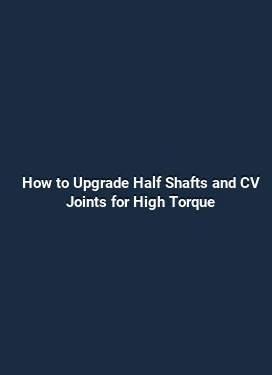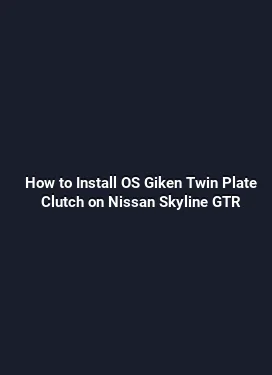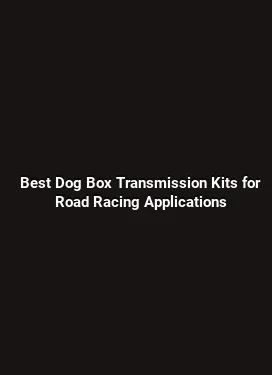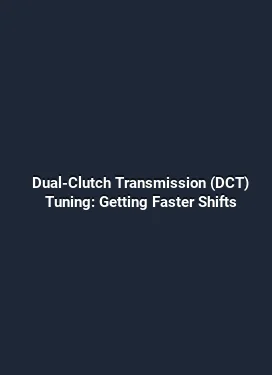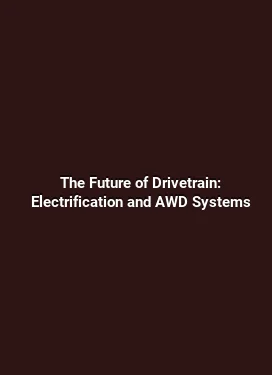Automatic Transmission Tuning Guide: Shift Points and Line Pressure
Understanding Transmission Tuning Fundamentals

Automatic transmissions rely on a finely balanced interplay between hydraulic control and electronic supervision to deliver smooth and responsive gear shifts. Tuning in this context refers to adjusting how the transmission interprets driver inputs and engine conditions, translating them into precise shift points and appropriate line pressure. The objective is to harmonize engine torque delivery with transmission response, producing shifts that feel perceptible yet seamless, while maintaining reliability across a wide range of operating scenarios.
In modern units, a combination of valve body hydraulics, clutch packs, torque converters, and electronic control units (ECUs) governs shifting. The valve body routes hydraulic pressure to apply and release clutches or bands, while the ECU or transmission control module (TCM) interprets sensor data—such as vehicle speed, throttle position, engine RPM, and torque output—to determine the optimal moment for each shift. Understanding how these subsystems interact provides a foundation for meaningful tuning and meaningful gains in drivability and efficiency.
Shift Points and Performance Potential
Shift points define when the transmission upshifts or downshifts in response to throttle input and vehicle dynamics. Fine-tuning shift points can unlock stronger acceleration, improved fuel economy, or smoother coast-down behavior, depending on the application. Central to this process is recognizing how engine torque curves intersect with gear ratios. For example, a torque-rich engine may benefit from later upshifts to stay within the torque band, while a high-revving or small displacement engine might require earlier shifts to protect the engine and sustain responsiveness.
Practical tuning often starts with establishing a baseline based on stock shift behavior under various driving conditions. From there, adjustments can be categorized as comfort-oriented (softer, smoother shifts), performance-oriented (sharper, quicker shifts), or efficiency-focused (optimal engine torque utilization with smoother transitions). A key detail is ensuring that shift logic remains cohesive across throttle positions and road conditions, avoiding abrupt transitions that can unsettle the vehicle dynamics or long-term component wear.
Throttle-Responsive Shifting

One effective approach is to create a tiered shift strategy that differentiates light throttle from aggressive throttle. At light throttle, the transmission may shift earlier to maximize efficiency and minimize engine braking. Under rapid throttle application, shifts can be delayed slightly to keep torque in play and deliver stronger acceleration. This requires calibration of pedal-to-fluid coupling and monitoring of engine speed relative to gear ratios to prevent abrupt engine revs or uncomfortable jolts.
Gear Ratio Considerations
Each gear ratio influences perceived power and response. When tuning, it is important to anticipate how the engine will respond in the next gear. For instance, if the next gear has a higher ratio and a lower RPM, the system may decide to upshift later to preserve momentum or downshift earlier to prevent over-revving when approaching a corner. A well-tuned system balances upshift timing with the vehicle’s intended use, whether daily commuting or track-like driving, ensuring predictable behavior across transitions.
Line Pressure Management and Hydraulic Control
Line pressure is the hydraulic force applied within the transmission to engage clutches and bands. It directly affects shift feel, clutch life, and the ability to hold gear under load. Adjusting line pressure can produce crisper shifts or smoother engagement, but excessive pressure can increase wear and parasitic losses. The art lies in modulating line pressure contextually—higher pressure for hard accelerations or demanding torque, and lower pressure for smooth cruising or fuel efficiency.
Hydraulic control systems rely on precise regulator valves, solenoids, and accumulator circuits to manage pressure in real time. When tuning, engineers may adjust pressure curves that respond to engine load, vehicle speed, and temperature. It is crucial to monitor the impact of these changes on shift timing as well as clutch thermal behavior, since sustained high pressure generates heat that can degrade friction materials if not managed properly.
Clutch Pack Health and Wear Patterns
Clutch packs are the primary friction interface in many automatic disassemblies. Tuning can influence how often these packs engage and the duration of engagement. A heavier line pressure often improves torque transfer during shifts but can accelerate wear. Conversely, reducing pressure can extend life but may lead to slippage or late engages under load. A practical approach is to pair line pressure adjustments with monitoring of slip RPM and temperature to ensure that engagement remains within safe and repeatable bounds.
Valve Body and Solenoid Dynamics
The valve body distributes hydraulic pressure through a network of channels controlled by solenoids. Fine-tuning these components involves calibrating the timing and intensity of pressure pulses to each clutch or band. Modern transmissions may employ adaptive strategies that learn from driving behavior, gradually refining shift characteristics. In performance-focused builds, engineers may implement deliberate delay or anticipation in solenoid activation to achieve desired shift dynamics, while protecting circuitry with appropriate thermal management.
Controller Strategies and Calibration
The controller side of tuning concerns software maps and heuristic rules that translate sensor inputs into mechanical actions. Calibration aims to create a responsive yet stable driving experience. This involves adjusting several layers, including throttle response interpretation, adaptive learning rate, temperature compensation, and shift-speed targets. The goal is to create a cohesive system in which electronic decisions align with mechanical realities and driver expectations.
Adaptive learning can be a double-edged sword. When properly configured, it helps the system accommodate wear, fuel quality, and campaign-specific driving styles. When misconfigured, it can produce on-off behavior or confusing shifts. A robust calibration strategy involves establishing baseline maps, enabling controlled adaptation, and validating outcomes with consistent testing across different terrains and load conditions.
Calibration Methodologies
A structured approach often begins with a diagnostic drive to capture baseline shift points, line pressures, and transient responses. Iterative testing—altering one variable at a time and documenting outcomes—helps isolate causal effects. It is also common to implement a torque- and RPM-based shift trigger, ensuring that the engine remains within its effective torque window during transitions. For heavy-duty applications, calibration may prioritize reliability and predictability over peak performance, emphasizing repeatable shifts under load and high temperatures.
Diagnostics and Data Interpretation
Effective tuning relies on data. Look for data points such as slip RPM during engagements, peak line pressure values, engine speed at each shift, and the duration of clutch engagement. Interpreting trends in these metrics helps determine whether the tuning is yielding the intended results or if adjustments are needed. A calm, methodical approach—documenting conditions like ambient temperature, fuel grade, and tire load—ensures that changes correlate with the operating environment rather than transient anomalies.
Practical Tuning Scenarios and Real-World Examples
Transmissions vary widely across platforms, from compact automatics to performance-tuned units. The following scenarios illustrate how tuning concepts translate into tangible improvements, while keeping longevity and reliability in focus.
Daily Driver with Pleasant Shifts
A common objective for everyday drivers is quiet, smooth operation with minimal delay when accelerating from a stop. In this context, the tuning emphasis is on soft engagements, early upshifts for reduced engine braking, and stable cruising shifts. The calibration may use moderate line pressure, gentle clutch engagement ramps, and shift points that favor comfort over outright speed. The outcome is a refined driving experience that remains efficient and dependable over long-term use.
Sporty Daily Driver
For drivers seeking greater immediacy, a sport-oriented setup can be employed. This might involve slightly later upshifts to keep the engine within a power band, quicker downshifts when approaching corners or overtaking, and a marginally higher line pressure during upshifts to minimize torque interruptions. The resulting shifts feel assertive without becoming harsh, maintaining control and confidence in dynamic driving conditions.
Heavy Load and Towing Scenarios
When a vehicle regularly operates under heavy load, calibrations prioritize maintaining gear under load and preventing excessive slip. Line pressure can be increased during high-torque phases, while shift points may be adjusted to prevent frequent downshifts that would waste power. A well-tuned setup also considers cooler operation, ensuring that slip and heat generation remain within safe limits for clutch packs and the valve body over extended periods.
Maintenance, Monitoring, and Longevity
Even the most advanced tuning needs support from routine maintenance. Regular fluid checks, proper fluid type, and adherence to service intervals are essential to preserve the intended transmission behavior. Monitoring for signs of wear, such as delayed engagements, slipping under load, or abnormal temperatures, helps identify when tuning adjustments should be revisited to prevent long-term damage.
Heat management is a critical factor in longevity. High line pressures and aggressive shifts generate additional thermal load. Effective cooling, clean hydraulic circuits, and clean fluid help mitigate premature wear. A practical practice is to track shift quality across temperature ranges, ensuring that the chosen calibration remains robust as environmental conditions fluctuate.
Safety, Reliability, and Driving Comfort
Any tuning strategy must balance performance with safety and reliability. The transmission should respond consistently to throttle inputs, maintain control during rapid maneuvers, and avoid unpredictable behavior that could compromise steering control or braking performance. A disciplined approach emphasizes incremental changes, validation under diverse driving conditions, and a clear understanding of the vehicle’s intended use profile.
For enthusiasts exploring upgrades, it is prudent to work with reputable service providers who have access to manufacturer-approved tools and calibration baselines. This ensures that tuning respects design tolerances, adheres to warranty considerations, and remains compatible with auxiliary systems such as towing electronics and drive-mode configurations.
Summary of Key Concepts
Shifts are a balance between engine torque, transmission hydraulics, and electronic guidance. Line pressure affects clutch engagement and heat generation, while shift points determine how quickly the vehicle accelerates or decelerates through gears. A cohesive tuning approach harmonizes these factors with the driver’s intent, delivering a controlled, responsive, and reliable drivetrain experience.

